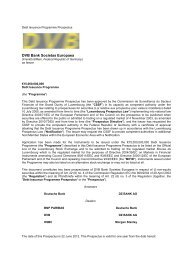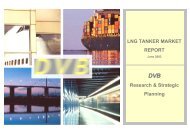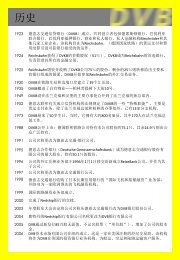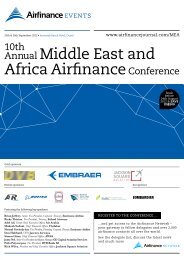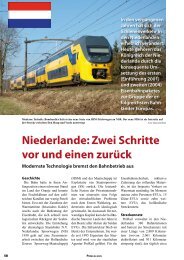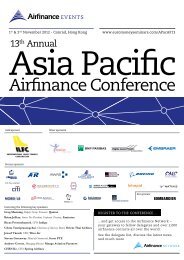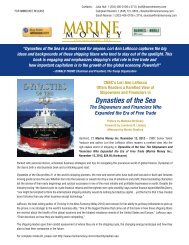BOEING'S 787 DREAMLINER - DVB Bank
BOEING'S 787 DREAMLINER - DVB Bank
BOEING'S 787 DREAMLINER - DVB Bank
Create successful ePaper yourself
Turn your PDF publications into a flip-book with our unique Google optimized e-Paper software.
The leading international magazine for the manufacturing and MRO sectors of commercial aviation<br />
BOEING’S <strong>787</strong> <strong>DREAMLINER</strong><br />
WHY PATIENCE WILL BE REWARDED<br />
■ IS THE DOWNTURN ACCELERATING PMA ACCEPTANCE?<br />
■ THE RISKS OF ENGINE LIFE CYCLE MANAGEMENT<br />
■ AIRCRAFT RECYCLING BEST PRACTICE<br />
■ ONLINE MAINTENANCE TOOLS<br />
October–November 2009 Issue: 102<br />
www.ubmaviationnews.com
ENGINEERING & MAINTENANCE<br />
Managing engines wisely<br />
An aero engine’s life cycle can be divided into three main stages: the financial, management and<br />
trading phases. Careful and far-sighted management is necessary to balance maintenance cost<br />
against operational risks whilst maintaining maximum asset value as the engine progresses<br />
through these different periods.<br />
When an aero engine needs to be taken<br />
off-wing for its first major overhaul or repair, it<br />
becomes important for the operator/owner to<br />
carefully assess its further maintenance plan<br />
and long-term asset objectives.<br />
54 ❙ Aircraft Technology - Issue 102 ❙<br />
Everything is rosy during the ‘honeymoon<br />
period’, the first years of an aero engine’s<br />
life cycle and main part of the initial financial<br />
phase. The power plant has been freshly<br />
delivered from the OEM and mated with its original<br />
operator who will generally be able to enjoy<br />
its daily faithful, revenue-creating service without<br />
worrying much about prolonged and expensive<br />
maintenance. Premature engine removals<br />
for component deterioration should be covered<br />
by the OEM as part of its product warranty, and<br />
even foreign object damage (FOD) events might<br />
fall under a separate insurance policy. Typically,<br />
the OEM will also make guarantees for fuel consumption,<br />
piece-part life and reliability, especially<br />
on new-generation equipment, and<br />
possibly even commit to cost per flight hour<br />
and/or flight cycle. Apart from ensuring compliance<br />
with the regulatory requirements and<br />
keeping a moderate level of technical oversight<br />
(to make sure the required maintenance and<br />
operational processes are safely and ade-<br />
quately working), the operator has no more<br />
engine management responsibility.<br />
But this sweet, uncomplicated life typically<br />
comes to an end after approximately seven<br />
years; although this does depend on the type<br />
of aircraft and its utilisation. At this point the<br />
engine is taken off wing for its first scheduled<br />
maintenance shop visit. The OEM’s warranty<br />
begins to expire in individual areas, and its<br />
financial support starts to dwindle. The engine<br />
becomes ‘adolescent’, as David Garrison, MD<br />
engine and component maintenance at Delta<br />
TechOps in Atlanta, US, puts it. For him, the<br />
operator has to take on more responsibility for<br />
the power plant’s maintenance planning in this<br />
second part of the financial phase. Garrison<br />
states: “During this phase one will be actively<br />
managing the unscheduled engine causes and<br />
determining the engine’s true capabilities<br />
based on the current design and the owner’s<br />
[airline or lessor] operating parameters.<br />
During this phase one is also analysing the
ENGINEERING & MAINTENANCE<br />
During the initial ‘honeymoon’ period of an engine’s life cycle, its maintenance is largely<br />
determined by the OEM’s product warranty policy and guarantees, and the operator/owner does<br />
not need to manage an engine plan.<br />
“We look at what is best for our<br />
customer’s requirements and<br />
do studies across a number of<br />
maintenance cost per flight<br />
hour agreements. We won’t<br />
always go for time and material<br />
if the power-by-the-hour<br />
contract makes more sense. It<br />
all depends on the engine,<br />
operator, any specifically harsh<br />
operating area or condition.”<br />
— Steve Froggatt, engineering<br />
manager, TES Aviation<br />
56<br />
❙ Aircraft Technology - Issue 102 ❙<br />
best life-limited part (LLP) management philosophy.”<br />
Power-by-the-hour<br />
A power-by-the-hour (PBH) or total support<br />
agreement with the OEM or an MRO provider is<br />
one option for the operator. This would allow<br />
continued flying without assuming the responsibility<br />
of balancing maintenance costs against<br />
operational risks and determining the maintenance<br />
planning. Normally, the engines stay in<br />
the service of the initial operator as there is<br />
only limited aircraft remarketing taking place at<br />
this point in time. The operator can pay the<br />
OEM/MRO an individually arranged, flight hourbased<br />
rate for their technical support services<br />
and concentrate on its main business of providing<br />
air transport. For example, Delta<br />
TechOps’s PBH contracts usually include fleet<br />
removal forecasting, service bulletin modification<br />
and inspection recommendations, on-wing<br />
engine condition monitoring, and the development<br />
of a maintenance programme, according<br />
to Garrison.<br />
However, even apparently comprehensive<br />
packages do not necessarily cover all eventualities<br />
that might concern an aircraft operator or<br />
owner. “One comment about total support is<br />
that all too often it is not really total support,”<br />
remarks Karl Gibson, operations director of<br />
TES Aviation, an aero engine management company<br />
based in the UK. He highlights that total<br />
support and PBH agreements always carry<br />
exclusions and might not cover certain work;<br />
FOD removal as an example. These extra-contractual<br />
maintenance events have then to be<br />
accomplished on the basis of their individual<br />
(man hour) time and material cost requirements.<br />
In that case the operator incurs both<br />
the cost of the regular PBH/total support payments,<br />
whether any regular maintenance work<br />
has actually been done or not, as well as the<br />
individual time and material-based payments<br />
for the additional work. Hence Gibson argues<br />
that, in order to forecast the entire MRO expenditure<br />
for an engine over a given period of time,<br />
the operator has to make an analysis of likely<br />
time and materials cost in the first place, irrespective<br />
of whether the company then decides<br />
to sign a PBH/total support contract or not.<br />
This does not mean that a PBH/total support<br />
agreement won’t still be the best option.<br />
“We look at what is best for our customer’s<br />
requirements and do studies across a number<br />
of maintenance cost per flight hour agreements,”<br />
explains Steve Froggatt, engineering<br />
manager at TES Aviation. “We won’t always go<br />
for time and material if the power-by-the-hour<br />
contract makes more sense. It all depends on<br />
the engine, operator, any specifically harsh<br />
operating area or condition.”<br />
For Abdol Moabery, CEO and president of GA<br />
Telesis, an aircraft asset management firm,<br />
component supplier and maintenance provider<br />
in Fort Lauderdale, Florida, the issue comes<br />
down to whether the operator wants to make<br />
regular payments to a PBH/total support<br />
provider for the maintenance in advance or pay<br />
for the individual events as they come along.<br />
“The provider of that [PBH/total support] service<br />
is accumulating cash for a 10 or 15-year<br />
programme. Some airlines view that cash as<br />
important to their business [now]. So they<br />
don’t want to pay up front and would rather just<br />
do it as time goes by.”<br />
Whatever decision is eventually made, it is of<br />
fundamental importance to get a clear understanding<br />
of the full maintenance cost that is<br />
likely to be encountered throughout the proposed<br />
service period for the engine. Although<br />
these expenditures can vary substantially<br />
between different operators and equipment, they<br />
can nevertheless be predicted with great precision<br />
over long periods of time. Analysing an<br />
engine’s remaining life cycle in light of its operational<br />
requirements and the financial objectives<br />
of its owner, if it is a leased engine, is the first<br />
step for any technical management team before<br />
determining the future maintenance plan.<br />
Management phase<br />
This becomes increasingly important as the<br />
engine progresses from the financial phase
ENGINEERING & MAINTENANCE<br />
The use of PMA parts and DER repairs instead of the standard OEM material and processes is one of the central questions when an engine enters the<br />
management phase and the future value strategy is determined.<br />
“The management phase is<br />
where most change is going to<br />
take place within an engine<br />
and its value. The management<br />
decisions one makes at that<br />
particular point, for a number<br />
of shop visits, is going to<br />
dictate the residual value when<br />
one gets towards the trading<br />
phase. As the lessor, one is<br />
looking more into the asset<br />
value, because one is looking<br />
at the end and what one wants<br />
to do with the asset. The<br />
operator, specifically, is looking<br />
at the cost per hour, because<br />
that’s what it is all about to<br />
turn a profit.”<br />
— Steve Froggatt, engineering<br />
manager, TES Aviation<br />
58<br />
❙ Aircraft Technology - Issue 102 ❙<br />
into the management phase. By then the powerplant<br />
is between 12 and 15 years old, may<br />
have transitioned from one operator to the<br />
next, its PBH/total support contract may be<br />
expiring, and it will need to come off-wing for its<br />
second, third or fourth shop visit. All product<br />
warranty and guarantees have finally expired,<br />
and the maintenance plan is no longer governed<br />
by the OEM’s product and repair developments.<br />
There will be a range of alternative<br />
PMA parts and DER repairs available on the<br />
market, which will give the operator/owner<br />
some choice to tailor the future maintenance<br />
plan to its individual needs. “The management<br />
phase is where most change is going to take<br />
place within an engine and its value,” states<br />
Froggatt. “The management decisions one<br />
makes at that particular point, for a number of<br />
shop visits, is going to dictate the residual<br />
value when one gets towards the trading phase<br />
[when the engine will eventually be disassembled<br />
to serve as a parts source]. As the lessor,<br />
one is looking more into the asset value,<br />
because one is looking at the end and what<br />
one wants to do with the asset. The operator,<br />
specifically, is looking at the cost per hour,<br />
because that’s what it is all about to turn a<br />
profit.”<br />
The main factors in the assessment of an<br />
engine’s remaining life cycle, which will indicate<br />
how long the engine may be able to stay onwing<br />
until the next shop visit, are aircraft utili-<br />
sation, the status of the LLPs and their remaining<br />
flight hours/cycles, the maintenance history,<br />
and the airworthiness directive (AD)<br />
status. If the analysis is performed from an<br />
operator’s perspective who has leased the<br />
engine, the length of the proposed service<br />
period is another major determinant. External<br />
engine management consultants are typically<br />
engaged in contracts over three or five years.<br />
Engine trend monitoring data at different power<br />
settings (usually idle, take-off and cruise) will<br />
provide a clear picture of the power plant’s current<br />
performance and what deterioration can<br />
be expected in terms of both extent and rate.<br />
Establishing the fuel flow and exhaust gas temperature<br />
(EGT) parameters will allow the management<br />
team to outline an initial overhaul<br />
strategy, according to Moabery. “As turbine<br />
blades get older, the wear starts to cause EGT<br />
margin degradation, and the engine will very<br />
quickly move from a strong performing engine<br />
to one that operates with no EGT margin.”<br />
Once all these parameters have been determined,<br />
it becomes possible to predict which<br />
maintenance tasks will be necessary in the<br />
future, what this will cost, what options the<br />
operator will have to control its spending, and<br />
how this might be affected by additional,<br />
unscheduled maintenance. “We run those<br />
engines forward on our system which allows us<br />
to forecast all the events. We would work-scope<br />
each engine individually as a paper exercise
ENGINEERING & MAINTENANCE<br />
Trading phase: when the value of the individual parts and components exceed the book value of a<br />
complete engine, it is teardown time and the asset will serve as a spare part source.<br />
“The risk of operating PMA<br />
parts are vast. The risks are<br />
calculated over a fleet of<br />
engines. So in the case of an<br />
airline with a vast fleet, one<br />
can look at that risk and<br />
decide it is worth doing. But<br />
the small operator may look at<br />
it and say, ‘for the cost savings<br />
that I save, it’s not worth it’.<br />
— Abdol Moabery, CEO and<br />
president, GA Telesis<br />
60<br />
❙ Aircraft Technology - Issue 102 ❙<br />
and identify what the costs were against the<br />
critical elements within that work scope, what<br />
the material costs would be based on the<br />
material standard that is in there [the engine],”<br />
explains Gibson. “We would include all the<br />
unscheduled events that could potentially happen,<br />
lease costs, everything ... and we would<br />
give them effectively what the cost per hour of<br />
their operation would be.”<br />
If it is a leased engine, the interests between<br />
the operator and owner are likely to diverge as<br />
indicated above. The airline might only be contractually<br />
obliged to release the engine with a<br />
certain life left on it at the end of the lease<br />
agreement. This would allow the company to<br />
minimise the workscope accordingly to reduce<br />
its costs during the lease period. On the other<br />
hand, however, the lessor will be looking at the<br />
cost of operation over the entire ownership<br />
period, which might go long beyond the original<br />
operator’s lease agreement. The lessor will want<br />
to enhance the workscope as much as possible<br />
in order to maintain a high asset value. This<br />
would make it more attractive and marketable to<br />
other operators who might lease the engine in<br />
the future. The two parties have then to find<br />
some common ground to keep the cost per hour<br />
of the engine at a level that is acceptable for<br />
both. If the lessor demands a technical standard<br />
that is significantly higher than what is necessary<br />
to the operator, one solution could be that<br />
the lessor makes a contribution to the maintenance<br />
cost.<br />
The use of PMA parts and DER repairs,<br />
instead of the standard OEM material and<br />
processes, is clearly one, if not the, most<br />
important and powerful means to reduce<br />
engine maintenance costs. However, while their<br />
use has been widely established throughout<br />
Western Europe and North America, this is not<br />
necessarily the case in all other regions. PMA<br />
parts can become an obstacle when trying to<br />
find a lessee for an overhauled engine, for<br />
example, in China and India — two future<br />
growth markets.<br />
But even within the boundaries of jurisdiction<br />
of the FAA and EASA, the cheaper alternative<br />
repair materials and processes might not<br />
always pay off either. In light of the increased<br />
operational risk of using PMA parts and DER<br />
repairs, the potential cost savings might be<br />
considered much less tempting for an airline<br />
with, for example, 10 aircraft than a carrier with<br />
a fleet of 100 aircraft. “The risks of operating<br />
PMA parts are vast,” believes Moabery. “The<br />
risks are calculated over a fleet of engines. So<br />
in the case of an airline with a large fleet, one<br />
can look at that risk and decide it is worth<br />
doing. But the small operator may look at it and<br />
say, ‘for the cost savings that I save, it’s not<br />
worth it’. If I have a major engine failure or a<br />
catastrophic event, then all of those savings<br />
are wiped out by one event.”<br />
Trading phase<br />
At approximately 20 years of age, the<br />
engine enters into the trading phase, the final<br />
part of its life cycle. By this time, the value of<br />
the entire aircraft is mainly driven by the engine<br />
value. Ironically, however, the book value of the<br />
power plant in itself is coming down so far at<br />
this point that it no longer warrants the cost for<br />
an overhaul. The engine’s technical standard<br />
and performance has been surpassed by its<br />
younger counterparts in the fleet, and possibly<br />
even by new-generation equipment that has<br />
emerged in the meantime. Furthermore, there<br />
will be an increased number of other engines of<br />
the same type and similar age on the market,
which have been phased out by other operators<br />
and have consequently brought down engine<br />
lease rates and spare part prices. Not only<br />
does it then become cheaper for the operator<br />
to swop an engine against a leased one rather<br />
than to repair or overhaul it, indeed there<br />
comes the point where the value of the individual<br />
parts and components exceed the book<br />
value of the complete engine. It is teardown<br />
time at this point and the engine will serve as<br />
a source for spare parts.<br />
The dynamics of the trading phase are subject<br />
to the economic conditions at the time. In<br />
periods of growth, when queues before airline<br />
check-in desks and OEM sales offices are long,<br />
the service lives of older aircraft are stretched<br />
too, and consequently lease prices for older<br />
engines with some residual ‘green-time’ are<br />
stable. ‘Green-time’ is the available period during<br />
which an older engine can remain in service<br />
until its last maintenance records expire and it<br />
will be torn down. Conversely, when the industry<br />
goes into a downturn and airlines are cutting<br />
capacity, the older, less efficient aircraft<br />
are the first ones to stay on the ground. “A<br />
good example right now is the CFM56-3 model<br />
[for 737 Classics], where there are so many<br />
spare engines available in the market that an<br />
operator may decide to run off ‘green-time’ on<br />
a leased engine as opposed to putting in $2-<br />
3m to repair the original engine,” reports<br />
Moabery.<br />
While the deferral of maintenance and<br />
using-up of surplus engines will help to drive<br />
older equipment permanently out of the market,<br />
it would be a short-sighted waste of material<br />
and finances to take advantage of aircraft<br />
capacity cuts in the current economic climate<br />
and apply the practice to younger equipment<br />
too. Garrison warns: “In the airline industry,<br />
economic cycles are a way of life and have a<br />
significant impact on an airline’s budget sensitivities.<br />
The airline industry is a cash hungry<br />
business and during an economic downturn,<br />
airlines work hard to preserve cash. This<br />
stance can make engine management very difficult,<br />
because you will need to invest in your<br />
fleet during the shop visit to make sure that<br />
you build in the goodness to obtain your engine<br />
run time and reliability plan. Airline customers<br />
who do not maintain the investment discipline<br />
during the economic downturns can expect<br />
their cost per hour and total cost to increase in<br />
future years.” ■<br />
ENGINEERING & MAINTENANCE<br />
In times of an economic downturn, when<br />
capacity is being cut and aircraft stored, it<br />
becomes even more attractive for airlines to<br />
defer pending maintenance and just swop or<br />
lease spare engines instead.<br />
❙ Aircraft Technology - Issue 102 ❙<br />
61



